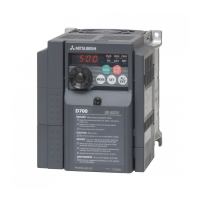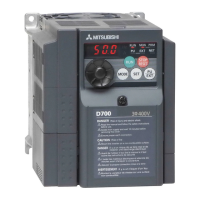How to unlock password locked Mitsubishi Electric FR-D700 Inverter?

How to unlock password locked Mitsubishi Electric FR-D700 Inverter?
| Series | FR-D700 |
|---|---|
| Overload Capacity | 150% for 60 seconds |
| Protection Class | IP20 |
| Enclosure Rating | IP20 |
| Communication | RS-485 |
| Output Frequency | 0.1 to 400 Hz |
| Control Method | V/f control, Vector control |
| Protection Functions | Overcurrent, Overvoltage, Undervoltage, Overload, Short circuit, Ground fault |
| Communication Options | RS-485 |
| Braking Unit | Optional external braking unit |
| Cooling Method | Fan cooled |
| Operating Temperature | -10 to 50 °C |
| Storage Temperature | -20 to +65°C |
| Ambient Humidity | 95% RH or less (non-condensing) |
| Altitude | Up to 1000 m |
| Dimensions (W x H x D) | Varies by model |
| Weight | Varies by model |
Guides users on how to unpack the inverter, check capacity plates, and identify all components.
Details the inverter and its compatible peripheral devices, including power supplies, reactors, and filters.
Provides instructions for removing and reinstalling the front and wiring covers of the inverter for access.
Covers environmental requirements, installation placement, and enclosure design for optimal inverter operation.
Explains the terminal connection diagram for main and control circuits, including safety signals and analog inputs.
Details specifications for main circuit terminals, power input, inverter output, and connections for optional units.
Outlines specifications for control circuit terminals, input/output signals, communication, and safety stop functions.
Describes connection procedures for optional units such as brake resistors, brake units, and converters.
Discusses electromagnetic compatibility, leakage currents, and countermeasures to reduce noise and interference.
Explains the installation of optional reactors for preventing peak currents and improving power factor.
Details the recommended use of magnetic contactors on the input and output sides for safety and maintenance.
Provides measures for surge voltage and insulation when driving 400V class motors, addressing potential insulation issues.
Lists general precautions for handling, wiring, and operating the inverter to prevent damage and ensure safety.
Explains how to configure interlocks and backup systems to ensure system safety in case of inverter failure.
Introduces the operation panel, its indicators, buttons, and basic functions for setting and monitoring parameters.
Provides a comprehensive list of all parameters, their settings, initial values, and related pages for detailed explanation.
Details how to adjust manual torque boost, magnetic flux vector control, and slip compensation for optimal motor performance.
Explains setting maximum/minimum frequencies and avoiding mechanical resonance points using frequency jumps.
Covers setting base frequency, voltage, and selecting load patterns for different V/F applications.
Describes setting frequency using multi-speed operations, jog, and remote settings via external terminals.
Details setting acceleration/deceleration times and patterns for smooth motor start and stop operations.
Covers motor overheat protection and selecting appropriate motors, including offline auto-tuning.
Explains DC injection braking, regenerative braking, and selection of motor stopping methods for controlled operation.
Details assigning functions to input/output terminals, including safety stop, communication, and various signals.
Explains selecting and displaying operating parameters on the panel, PU, and terminal FM for monitoring purposes.
Covers automatic restart and power-failure deceleration stop functions for reliable operation during power interruptions.
Describes retry functions and fault detection mechanisms for managing and responding to inverter faults.
Explains optimizing energy consumption, such as using optimum excitation control, especially for fan and pump applications.
Details techniques to reduce motor noise, suppress EMI, and avoid mechanical resonance via PWM carrier frequency and speed smoothing.
Covers analog input selection, bias/gain adjustment, and performing operations with analog signals for frequency control.
Explains functions like reset selection, PU disconnection detection, parameter write disable, and password protection to prevent errors.
Describes selecting operation modes (PU, External, Network) and managing command sources for flexible control configurations.
Details communication setup for PU connector, RS-485, Modbus-RTU, and computer link operations for remote control.
Explains how to reset the inverter after a fault, including procedures for operation panel, power reset, and RES signal.
Provides a comprehensive list of all inverter fault and alarm codes, their indications, and corresponding troubleshooting pages.
Details common causes for errors, warnings, alarms, and faults, along with their respective corrective actions.
Lists the mapping between digital characters displayed on the operation panel and their alphanumeric representations.
Provides a systematic checklist for common issues like motor not starting or abnormal noise, guiding users to potential causes and solutions.
Outlines daily and periodic inspection checks for the inverter, including motor operation, environment, cooling system, and parts condition.
Explains how to measure main circuit voltages, currents, and powers using various instruments for diagnostics and performance checks.
Details the electrical ratings of the inverter series, including power supply voltage, capacity, current, and regenerative braking torque.
Lists common specifications for the FR-D700 series, covering control methods, frequency settings, input/output signals, and environmental conditions.
Provides mechanical dimensions and panel cut-out drawings for various inverter models, aiding in installation planning.










